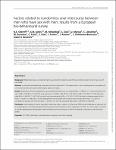Factors related to condomless anal intercourse between men who have sex with men: results from a European bio-behavioural survey
Sherriff, N. S.
Jones, A. M.
Mirandola, M.
Gios, L.
Marcus, U.
Llewellyn, C.
Rosinska, M.
Folch, C.
Dias, S.
Toskin, I.
Alexiev, I.
Kühlmann-Berenzon, S.
Sialon II Network
Background
Relationship status is an important factor associated with condomless anal intercourse (CAI) amongst men who have sex with men (MSM).
Methods
A multi-centre bio-behavioural survey with MSM was conducted in 13 European cities (n = 4901) exploring factors associated with CAI via bivariate and multivariate multilevel logistic regression analyses.
Results
Likelihood of CAI with casual partners was associated with being ‘out’ to a majority (AOR = 1.19;95% CI 1,1.42); knowing their HIV status (AOR = 1.86; 95% CI 1.25,2.76); using substances (1–2 AOR = 1.39; 95% CI 1.16,1.63, 2+ AOR = 1.81; 95% CI 1.35,2.42); being older (AOR = 0.98; 95% CI 0.97,0.99); successful sero-communication (AOR = 0.79; 95% CI 0.67,0.94); and, not having a recent HIV test (AOR = 0.78; 95% CI 0.66,0.92). CAI with steady partners was associated with successful sero-communication (AOR = 2.72; 95% CI 2.72,3.66); not having a recent HIV test (AOR = 1.26; 95% CI 1.09,1.46), and; being older (AOR = 0.99; 95% CI 0.98,0.99).
Conclusions
Understandings of partner type and/or relationship status in relation to CAI amongst MSM can potentially play an important role in the development of culturally appropriate HIV/STI prevention and risk-reduction efforts targeting at-risk MSM. Our results speak to the need to consider segmented and tailored public health and health promotion initiatives for MSM with differing CAI behaviours and relationship profiles.

